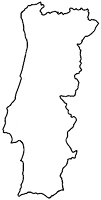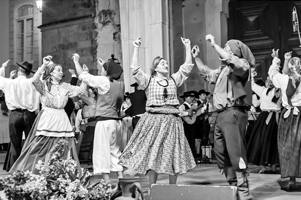
|
The Society of Folk Dance Historians (SFDH)
Folk Dances of Portugal
[
Home |
About |
Encyclopedia | CLICK AN IMAGE TO ENLARGE |

|
 From the land of pouco tempo – Minho Province, where it seems time has stood still in the undisturbed beauty of the countryside, to the fiery sun-baked slopes of mountainous Algarve, Portugal's 350-mile length abounds in a rich wealth of folk dances and costumes. As one travels south from the Spanish Galician border, the mood of the music and dance seems to keep pace with the climate. East to west (and there is not too much distance here – at the widest part, scarce 140 miles), the leaps and bounds the dancers utilize to keep warm in the winter heights of the Tras-os-Montes smooth out as they reach the coast and the fisher dances of the Litoral and Estramadura.
From the land of pouco tempo – Minho Province, where it seems time has stood still in the undisturbed beauty of the countryside, to the fiery sun-baked slopes of mountainous Algarve, Portugal's 350-mile length abounds in a rich wealth of folk dances and costumes. As one travels south from the Spanish Galician border, the mood of the music and dance seems to keep pace with the climate. East to west (and there is not too much distance here – at the widest part, scarce 140 miles), the leaps and bounds the dancers utilize to keep warm in the winter heights of the Tras-os-Montes smooth out as they reach the coast and the fisher dances of the Litoral and Estramadura.
Probably, these dances of the fishermen are the best known of Portuguese dances, at least, to the tourist and through them, the international folk dancer. Many are very localized, seen only in their respective villages, and then only on special festive occasions. Because, perhaps, there is quite a scarcity of Portuguese dance in notated form. The dances of the country are not well known outside of Portugal itself and Portuguese ethnic colonies abroad. Exceptions to this would be the various Viras and Chamarritas, and some Portuguese variants of Fandango.
Most of the outdoor folk dancing in Portugal occurs during the months of April through October, which is the occasion of most of the fiestas and Romarias. Nowadays however, enterprising Portuguese restauranteurs and theatrical producers have brought Portuguese folk culture to the cities, the tourist trade, and to a small degree of commercialism. "Fados" have long been sung in the cabarets of Lisbon, Oporto, and other urban centers. In recent years however, "folclor" has been turning up in the nightclubs and this "folclor" is folk dancing, both as stage perfomances by groups and (in smaller taverns) as participation activities.
 Some examples of Portuguese dances from different provinces, and even areas of the same province, show a great diversity and characteristics which show influences of distant lands. This however is a common denominator to many maritime countries, where the sailors and fisher folk bring back examples of the cultures of other peoples along with their normal tradings.
Some examples of Portuguese dances from different provinces, and even areas of the same province, show a great diversity and characteristics which show influences of distant lands. This however is a common denominator to many maritime countries, where the sailors and fisher folk bring back examples of the cultures of other peoples along with their normal tradings.
Dances of the Estramadura and the coast northward include the fishermen's dances which seem to picture the winding of coils of rope and the weaving of fishing nets, danced to an elusive rhythm. A village dance in Beira Litoral has a dance that is performed by young women, Dança Cantarinhas, where the dancers carry jars on their heads filled with sand and draped with flowers and perform a series of intricate figures with their steps in 3/4 time. In the town of Nazaré on the coast, there are numerous local dances. Here, in addition to the fisher dances, one will also find their local Vira. The festival of Our Lady of Nazaré in September is one of the better-known-to-tourists events, and for three days, much dancing may be seen.
Up north in Minho there is a variety of dances. In addition to the Vira (Minho's is different from that of Lisbon or Nazaré) there is a contra-type Jota, a similar but faster version called Pretinho, and a couple dance called Pai do Ladrãg;, and a two-couple set similar in formation to the Vira called Verdegaio. A castanet dance, Chula, is in longways form with leaping turns.
South of the Tagus on the plains of Alentejo Alto and Baixo, there is not much dancing. What there is, is only occasional, such as the annual May Fair in Estramoz and the August festival in Beja which occupies two full weeks. Other occasions are Christmas and the local Romerias. Dances here are less hectic, arms carried lower with fewer leaps. The people are poorer and after a hard day's work in the fields, legs are tired and aching, especially if there was a long walk from home to the place of the dance. In the Algarve, the hot sun brings out the fiery dance, the Corridinho, regional dance of the area which is a couple-type Polka. To the extreme south, a dance of which variations may be found throughout Latin America, the Bança dos Mouros, the Dance of the Christians and Moors, that commemorates the battles between them. This area and Spanish Granada being the last strongholds of the Moriscans in Europe.
Within a fifty-mile radius of Lisbon may be found at least three major dance influences, the "fishermen's dances" of Estramadura, the "cowboy dances" of the Campinos of the Ribatejo, and the "mountain dances" of the Beira. Of the second group, the Padeirinha and the Fandango danced at Vila Franca de Xira are great examples of exciting precision dancing. It is also in this village that the famous festival of the "red waistcoat" is put on every July, with a free-for-all running of bulls, but not the dangerous kind of Basque renown.
As in most European countries, Portugal also has many "ritual" dances. In addition to the previously mentioned Christian-Moor dances, there are others such as "Maypole" dances of Beira; a Pinhata (read our Latin American "piñata) dance during Carnival time in Lisbon; Morris-type (including sticks, bells, and ribbons) dances from the far northeast; midsummer eve dances; and others relating to the seasons and holidays. These are rarely seen beyond the confines of their particular local towns or on occasions other than the prescribed date for celebration.
Best known of Portuguese dances here among the Portuguese-Americans is the Chamarrita (with two or three spellings?). This, a large circle, in usually 3/4 time, has a caller who, outside or within the circle, calls the various changes of step or direction to the dancers. It seems to have crossed the Atlantic Ocean, and the continent, brought by immigrants from the Azores. There are a host of folklore tales concerning its origin. Who knows which is correct? What really matters is that when the call comes to join the Chamarrita, there will always be a rush towards the sound of the music by the throng of dance-happy Lusitanians.
DOCUMENTS
Printed in Folk Dance Scene, May 1981.
This page © 2018 by Ron Houston.
Please do not copy any part of this page without including this copyright notice.
Please do not copy small portions out of context.
Please do not copy large portions without permission from Ron Houston.